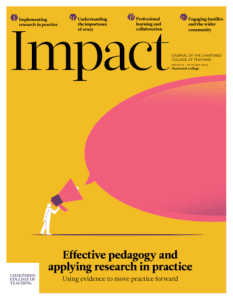A case study on saving time: Effective marking and feedback in Geography
Written by: George Davies-Craine

5 min read
George Davies-Craine, Dr Challoner's Grammar School, UK
Marking and feedback is a contentious and debated issue in education. In many cases, it is a high-workload process with a low impact, often leading to students not understanding concepts better nor producing higher-quality work. The reasons for this are twofold: firstly, there is often a time gap between feedback and improvement, and secondly the least able are most in need of the feedback, which they are least likely to be able to interpret (Sherrington, 2017). Then there is the issue of time spent marking: sets of fully marked books are often seen as a traditional proxy for good teaching (Hendrick and Macpherson, 2017). The time spent acknowledging every piece of work through processes such as ‘tick and flick’ or by placing a generic comment on every piece of classwork can be better spent giving specific information to the student on how to improve their work. Therefore, in light of this, fewer pieces of work should be mark
Join us or sign in now to view the rest of this page
You're viewing this site as a guest, which only allows you to view a limited amount of content.
To view this page and get access to all our resources, join the Chartered College of Teaching (it's free for trainee teachers and half price for ECTs) or log in if you're already a member.
- Black P, Harrison C, Lee C et al. (2002) Working Inside the Black Box: Assessment for Learning in the Classroom. London: GL Assessment.
- Brown G and Harris L (2014) The future of self-assessment in classroom practice: reframing self-assessment as a core competency. Frontline Learning Research 2(1): 22–30.
- Csikszentmihalyi M (2002) Flow. London: Random House.
- Elliott V, Baird J-A, Hopfenbeck T et al. (2016) A marked improvement? A review of the written evidence on marking. Education endowment Foundation. Available at: https://educationendowmentfoundation.org.uk/education-evidence/evidence-reviews/written-marking (accessed April 2023).
- Hendrick C and Macpherson R (2017) What Does This Look Like in the Classroom: Bridging the Gap Between Research and Practice. Woodbridge: John Catt Educational.
- Kluger AN and DeNisi A (1996) The effects of feedback interventions on performance: A historical review, a meta-analysis, and a preliminary feedback intervention theory. Psychological Bulletin 119(2): 254–284.
- Sherrington T (2017) The Learning Rainforest: Great Teaching in Real Classrooms. Woodbridge: John Catt Educational.
4
1
vote
Please Rate this content
Subscribe
Please login to comment
0 Comments
Oldest
Newest
Most Voted
Inline Feedbacks
View all comments










